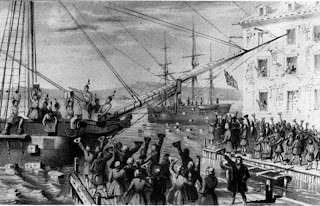 Today my former Canadian History professor, Graham Broad, sent me a link to the Ultimate Canadian History Site, explaining that it was created for the Grade 10 Social Studies class and very blog worthy. As I am always looking for interesting things to write about, I clicked on the link and was surprised by what I saw. This site did not appear to be a typical curriculum based history website at all, with the home page containing pictures of people with pretend Maple Leaf tattoos on their faces...but I knew I was at the right place when the first activity I noticed was “History Songs” which encourages students to “sing yourself through your social studies classes”.
Today my former Canadian History professor, Graham Broad, sent me a link to the Ultimate Canadian History Site, explaining that it was created for the Grade 10 Social Studies class and very blog worthy. As I am always looking for interesting things to write about, I clicked on the link and was surprised by what I saw. This site did not appear to be a typical curriculum based history website at all, with the home page containing pictures of people with pretend Maple Leaf tattoos on their faces...but I knew I was at the right place when the first activity I noticed was “History Songs” which encourages students to “sing yourself through your social studies classes”. Overwhelmed by curiosity I clicked on the History Songs section and started simultaneously reading into the background of the site and downloading a song entitled “Louis Louis Riel”. I quickly learned that this website was created by Shawna Audet, who began writing social studies songs to get her students more interested in Canadian History; not only did her creative approach work with her students, but Audet was also funded by Historica to compile her history songs into an album entitled Beaver Tales (academics will be happy to know she includes notes on each of her songs). Audet has still made all of the songs downloadable on her site, and encourages people to purchase the album to show they support the product.
Audet has also completed historical research in order to create history quizzes that allow to students to find out which historical figures they are most like, and her latest project “Mini-Canada” encourages students to think about what it means to be Canadian. The description of this project asks students, “What does it mean to be Canadian? This question doesn't come with a simple little answer that we can all memorize before we move on to our next social studies lesson. Instead, it leads to more questions. For example, what do Canadians look like? What do Canadians value?” This project involves students doing research using Statistic Canada, thinking independently about their findings, and presenting their information in video format, which can be uploaded and watched on the website.
The website itself has some serious weaknesses: I found it hard to navigate, some of the links did not work properly, and I could not find where to sign up so that I could take the quizzes. I also have not had the chance to really look into the quality of the historical content. That being said, I really like the enthusiasm and sense of fun that Audet brings to the study of history. As many of my blogs have stressed, I am really inspired by people and institutions that dare to present history in unique and dynamic ways. Audet demonstrates that getting people excited about history can be something as simple (and silly) as the history songs, which have the potential to make people laugh and learn at the same time.





